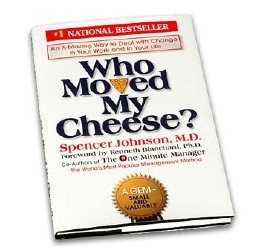Grad View
Social and business etiquette can be tricky, and making the right moves can make a big difference. Take this quiz and see how you fare in the following business situations. The answers are at the bottom of the page.
1. Your boss, Ms. Alpha, enters the room when you're meeting with an important client, Mr. Beta. You rise and say "Ms. Alpha, I'd like you to meet Mr. Beta, our client from San Diego." Is this introduction correct?
2. At a social function, you meet the CEO of an important Japanese corporation. After a brief chat, you give him your business card. Is this correct?
3. You're entering a cab with an important client. You position yourself so the client is seated curbside. Is this correct?
4. You're hosting a dinner at a restaurant. You've pre-ordered for everyone and indicated where they should sit. Are you correct?
5. A toast has been proposed in your honor. You say "thank you" and take a sip of your drink. Are you correct?
6. You're in a restaurant and a thin soup is served in a cup with no handles. To eat it you should:
a. pick it up and drink it
b. use the spoon provided
c. eat half of it with a spoon and drink the remainder
7. You're at a dinner and champagne is served with the dessert. You simply can't drink champagne yet know the host will be offering a toast. Do you:
a. tell the waiter "no champagne"
b. turn over your glass
c. ask the waiter to pour water into your champagne glass instead
d. say nothing and allow the champagne to be poured
8. You're at a table in a restaurant for a business dinner. Midway through the meal, you're called to the telephone. What do you do with your napkin?
a. Take it with you
b. Fold and place it to the left of your plate
c. Loosely fold it and place it on the right side
d. Leave it on your chair
9. You're hosting a dinner party at a restaurant. Included are two other couples, and your most valuable client and his wife. You instruct the waiter to:
a. serve your spouse first
b. serve your client's spouse first
c. serve you and your spouse last
10. You're invited to a reception and the invitation states "7:00 to 9:00 PM." You should arrive:
a. at 7:00 PM
b. anytime between 7:00 PM and 9:00 PM
c. between 7:00 PM and 7:30 PM
d. go early and leave early
11. You're greeting or saying good-bye to someone. When's the proper time to shake their hand?
a. When you're introduced
b. At their home
c. At their office
d. On the street
e. When you say good-bye
12. You're talking with a group of four people. Do you make eye contact with:
a. just the person to whom you're speaking at the moment?
b. each of the four, moving your eye contact from one to another?
c. no one particular person (not looking directly into anyone's eyes)?
13. The waiter's coming toward you to serve wine. You don't want any. You turn your glass upside down. Are you correct?
14. When you greet a visitor in your office, do you:
a. say nothing and let her sit where she wishes?
b. tell her where to sit?
c. say "Just sit anywhere"
15. You're invited to dinner in a private home. When do you take your napkin from the table and place it on your lap?
a. Open it immediately
b. Wait for the host to take his napkin before taking yours?
c. Wait for the oldest person at the table to take his?
d. Wait for the acknowledged head of the table to take hers before taking yours?
16. You're scheduled to meet a business associate for working lunch and you arrive a few minutes early to find a suitable table. 30 minutes later your associate still hasn't arrived. Do you:
a. order your lunch and eat?
b. continue waiting and fuming that your associate isn't there?
c. tell the head waiter you're not staying and give him our card with instructions to present it to your associate to prove you were there?
d. after 15 minutes call your associate?
17. You've forgotten a lunch with a business associate. You feel terrible and know he's furious. Do you:
a. write a letter of apology?
b. send flowers?
c. keep quiet and hope he forgets about it?
d. call and set up another appointment?
Now lets see how you did...
1. No. Introduce the more important person first. You should address your client and say "Mr. Beta, I'd like you to meet our Vice President of Development, Ms. Alpha." (Alternative answer?introduce the client as the more important person!)
2. No. In Japan (unlike in the United States or the UK), business cards are taken as a serious reflection of their owner and are exchanged with great ceremony. Researching the importance of business cards in various cultures can help in avoiding embarrassing faux pas.
3. Yes. When your client steps out of the car, (s)he will be on the curbside and therefore won't have to deal with getting out in traffic or sliding across the seat.
4. Yes
5. No. If you do, then you're toasting yourself.
6. B. It's not a cup of coffee, for heaven's sake. And don't slurp, either.
7. D. It's more polite not to call attention to the fact that you can't drink champagne.
8. D. Leave it on your chair. Definitely don't put it on the table--what if you have crumbs on it?
9. B and C. Sort of a trick question, but this is important.
10. A, B, or C. It's terribly impolite to arrive early.
11. A, B, C, D, and E. In other words, it's rarely improper to shake someone's hand. Make sure you have a firm (but not painful) handshake for both men and women.
12. B. Make eye contact with all of the individuals you're talking with.
13. No. Again, don't call attention to your dislike of your host's chosen beverage.
14. B. Indicating where your guest should sit will make her feel more comfortable.
15. B, C, or D. Just don't grab it first unless you're playing one of these roles.
16. A. You've waited 30 minutes. Expect an apology later, though.
17. D. Call and set up another appointment. And don't forget to apologize for your error. Imagine how you'd feel if it was you!
http://www.gradview.com/articles/careers/etiquette.html












.jpg)



